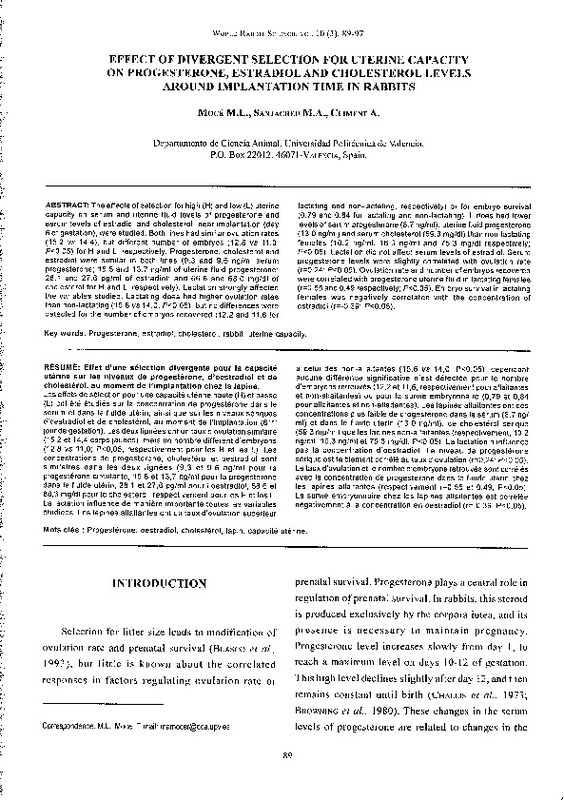JavaScript is disabled for your browser. Some features of this site may not work without it.
Buscar en RiuNet
Listar
Mi cuenta
Estadísticas
Ayuda RiuNet
Admin. UPV
EFFECT OF DIVERGENT SELECTION FOR UTERINE CAPACITY ON PROGESTERONE, ESTRADIOL AND CHOLESTEROL LEVELS AROUND IMPLANTATION TIME IN RABBITS
Mostrar el registro sencillo del ítem
Ficheros en el ítem
| dc.contributor.author | Mocé, M.L.
|
|
| dc.contributor.author | Santacreu, M.A.
|
|
| dc.contributor.author | Climent, A.
|
|
| dc.date.accessioned | 2011-02-24T13:11:51Z | |
| dc.date.available | 2011-02-24T13:11:51Z | |
| dc.date.issued | 2002 | |
| dc.identifier.issn | 1257-5011 | |
| dc.identifier.uri | http://hdl.handle.net/10251/9995 | |
| dc.description.abstract | [EN] The effects of selection for high (H) and low (L) uterine capacity on serum and uterine fluid levels of progesterone and serum levels of estradiol and cholesterol, near implantation (day 6 of gestation), were studied. Both lines had similar ovulation rates (15.2 vs 14.4), but different number of embryos (12.8 vs 11.0; P<0.05) for H and L, respectively. Progesterone, cholesterol and estradiol were similar in both lines (9.3 and 9.6 ng/ml serum progesterone; 15.6 and 13. 7 ng/ml of uterine fluid progesterone; 28.1 and 27.6 pg/ml of estradiol; and 66.6 and 68.0 mg/dl of cholesterol for H and L, respectively). Lactation strongly affected the variables studied. Lactating does had higher ovulation rates than non-lactating (15.6 vs 14.0; P<0.05), but no differences were detected for the number of embryos recovered (12.2 and 11.6 for lactating and non-lactating, respectively) or for embryo survival (O. 79 and 0.84 for lactating and non-lactating). L does had lower levels of serum progesterone (8. 7 ng/ml), uterine fluid progesterone (13.0 ng/ml) and serum cholesterol (59.3 mg/dl) than non-lactating females (10.2 ng/ml, 16.3 ng/ml and 75.3 mg/dl respectively; P<0.05). Lactation did not affect serum levels of estradiol. Serum progesterone levels were slightly correlated with ovulation rate (r=0.24; P<0.05). Ovulation rate and number of embryos recovered were correlated with progesterone uterine fluid in lactating females (r=0.55 and 0.49 respectively; P<0.05). Embryo survival in lactating females was negatively correlated with the concentration of estradiol (r=-0.39; P<0.05). | es_ES |
| dc.description.abstract | [FR] Les effets de sélection pour une capacité utérine haute (H) et basse (L) -:int été étudiés sur la concentration de progestérone dans le sérum et dans le fluide utérin, ainsi que sur les niveaux sériques d'oestradiol et de cholestérol, au moment de l'implantation (6•m• jour de gestation). Les deux lignées ont un taux d'ovulation similaire (15,2 et 14,4 corps jaunes), mais un nombre différent d'embryons (12,8 vs 11,0; P<0,05, respectivement pour les H et les L). Les concentrations de progestérone, cholestérol et oestradiol sont similaires dans les deux lignées (9,3 et 9,6 ng/ml pour la progestérone circulante, 15,6 et 13,7 ng/ml pour la progestérone dans le fluide utérin, 28, 1 et 27,6 pg/ml pour l'oestradiol, 66,6 et 68,3 mg/dl pour le cholestérol, respectivement pour les H et les L. La lactation influence de maniere importante toutes les variables étudiées. Les lapines allaitantes ont un taux d'ovulation supérieur a celui des non-allaitantes (15,6 vs 14,0; P<0,05), cependant aucune différence significative n'est détectée pour le nombre d'embryons retrouvés (12,2 et 11,6, respectivement pour allaitantes et non-allaitantes) ou pour la survie embryonnaire (0,79 et 0,84 pour allaitantes et non-allaitantes). Les lapines allaitantes ont des concentrations plus faible de progestérone da ns le sérum (8,7 ng/ mi) et dans le fluide utérin (13,0 ng/ml), de cholestérol sérique (59,3 mg/ml) que les la pines non-allaitantes (respectivement, 10,2 ng/ml, 16,3 ng/ml et 75,3 mg/dl, P<0,05). La lactation n'influence pas la concentration d'oestradiol. Le niveau de progestérone sérique est faiblement corrélé au taux d'ovulation (r=0,24; P<0,05). Le taux d'ovulation et le nombre d'embryons retrouvés sont corrélés avec la concentration de progestérone dans le fluide utérin chez les lapines allaitantes (respectivement r=0,55 et 0,49; P<0,05). La survie embryonnaire chez les lapines allaitantes est corrélée négativement a la concentration en oestradiol (r=-0,39; P<0,05). | |
| dc.description.sponsorship | We are grateful to Professor Agustín Blasco for his statistical support and to Dr. Alfonso Abecia and Dr. Fernando Forcada, and to Olga Zúnñiga for the laboratory support. This work was supported by CICYT AGF 200-1679 | |
| dc.language | Inglés | es_ES |
| dc.publisher | World Rabbit Science. ICTA. UPV | es_ES |
| dc.relation.ispartof | World Rabbit Science | |
| dc.rights | Reserva de todos los derechos | es_ES |
| dc.subject | Progesterone | |
| dc.subject | Estradiol | |
| dc.subject | Cholesterol | |
| dc.subject | Rabbit | |
| dc.subject | Uterine capacity | |
| dc.subject | Lapin | |
| dc.subject | Capacité utérine | |
| dc.title | EFFECT OF DIVERGENT SELECTION FOR UTERINE CAPACITY ON PROGESTERONE, ESTRADIOL AND CHOLESTEROL LEVELS AROUND IMPLANTATION TIME IN RABBITS | es_ES |
| dc.type | Artículo | es_ES |
| dc.date.updated | 2011-02-24T13:08:48Z | |
| dc.identifier.doi | 10.4995/wrs.2002.480 | |
| dc.relation.projectID | info:eu-repo/grantAgreement/MICYT//AGL2000-1679/ES/EFECTO DE LA SELECCION SOBRE LA ACTIVIDAD ENZIMATICA Y HORMONAL DEL CONEJO/ | |
| dc.rights.accessRights | Abierto | es_ES |
| dc.description.bibliographicCitation | Mocé, M.; Santacreu, M.; Climent, A. (2002). EFFECT OF DIVERGENT SELECTION FOR UTERINE CAPACITY ON PROGESTERONE, ESTRADIOL AND CHOLESTEROL LEVELS AROUND IMPLANTATION TIME IN RABBITS. World Rabbit Science. 10(3):89-97. https://doi.org/10.4995/wrs.2002.480 | es_ES |
| dc.description.accrualMethod | SWORD | es_ES |
| dc.relation.publisherversion | https://doi.org/10.4995/wrs.2002.480 | |
| dc.description.upvformatpinicio | 89 | |
| dc.description.upvformatpfin | 97 | |
| dc.description.volume | 10 | |
| dc.description.issue | 3 | |
| dc.identifier.eissn | 1989-8886 | es_ES |
| dc.contributor.funder | Ministerio de Ciencia y Tecnología |








